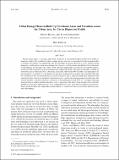| dc.contributor.author | Hanna, Steven | |
| dc.contributor.author | Marciotto, Edson | |
| dc.contributor.author | Britter, Rex E. | |
| dc.date.accessioned | 2011-12-01T20:17:14Z | |
| dc.date.available | 2011-12-01T20:17:14Z | |
| dc.date.issued | 2011-06 | |
| dc.date.submitted | 2010-05 | |
| dc.identifier.issn | 1558-8424 | |
| dc.identifier.issn | 1558-8432 | |
| dc.identifier.uri | http://hdl.handle.net/1721.1/67345 | |
| dc.description.abstract | Surface energy fluxes, at averaging times from 10 min to 1 h, are needed as inputs to most state-of-the-art dispersion models. The sensible heat flux is a major priority, because it is combined with the momentum flux to estimate the stability, the wind profile, and the turbulence intensities. Because of recent concerns about dispersion in built-up downtown areas of large cities, there is a need to estimate sensible heat flux in the midst of tall buildings. In this paper, the authors work with some high-quality and relevant but arguably underutilized data. The results of analysis of urban heat flux components from 10 locations in suburban and built-up downtown areas in Oklahoma City, Oklahoma, during the Joint Urban 2003 (JU2003) field experiment are presented here. At street level in the downtown area, in the midst of tall skyscrapers, the ground heat flux and the sensible heat flux are relatively large and the latent heat flux is relatively small when compared with concurrent fluxes observed in the upwind suburban areas. In confirmation of measurements in other cities, the sensible heat flux in the downtown area is observed to be slightly positive (10–20 W m[superscript −2]) at night, indicating nearly neutral or slightly unstable conditions. Also in agreement with observations in other cities is that the ground heat flux in the downtown area has a magnitude that is 3 or 4 times that in suburban or rural areas. These results should permit improved parameterizations of sensible heat fluxes in the urban downtown area with tall buildings. | en_US |
| dc.description.sponsorship | National Science Foundation (U.S.) (Award 0750878) | en_US |
| dc.description.sponsorship | Singapore. National Research Foundation | en_US |
| dc.description.sponsorship | Singapore-MIT Alliance for Research and Technology | en_US |
| dc.description.sponsorship | Singapore-MIT Alliance. Center for Environmental Sensing and Monitoring | en_US |
| dc.language.iso | en_US | |
| dc.publisher | American Meteorological Society | en_US |
| dc.relation.isversionof | http://dx.doi.org/10.1175/2011jamc2555.1 | en_US |
| dc.rights | Article is made available in accordance with the publisher's policy and may be subject to US copyright law. Please refer to the publisher's site for terms of use. | en_US |
| dc.source | AMS | en_US |
| dc.title | Urban Energy Fluxes in Built-Up Downtown Areas and Variations across the Urban Area, for Use in Dispersion Models | en_US |
| dc.type | Article | en_US |
| dc.identifier.citation | Hanna, Steven, Edson Marciotto, and Rex Britter. “Urban Energy Fluxes in Built-Up Downtown Areas and Variations across the Urban Area, for Use in Dispersion Models.” Journal of Applied Meteorology and Climatology 50 (2011): 1341-1353. Web. 1 Dec. 2011. © 2011 American Meteorological Society | en_US |
| dc.contributor.department | Massachusetts Institute of Technology. Department of Urban Studies and Planning | en_US |
| dc.contributor.approver | Britter, Rex E. | |
| dc.contributor.mitauthor | Britter, Rex E. | |
| dc.relation.journal | Journal of Applied Meteorology and Climatology | en_US |
| dc.eprint.version | Final published version | en_US |
| dc.type.uri | http://purl.org/eprint/type/JournalArticle | en_US |
| eprint.status | http://purl.org/eprint/status/PeerReviewed | en_US |
| dspace.orderedauthors | Hanna, Steven; Marciotto, Edson; Britter, Rex | en |
| mit.license | PUBLISHER_POLICY | en_US |
| mit.metadata.status | Complete | |
